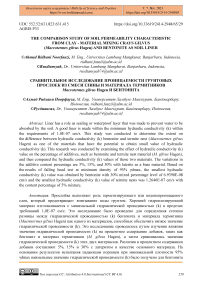The comparison study of soil permeability characteristic from clay - material mixing crays gilvus (Macrotermes gilvus Hagen) and bentonite as soil liner
Автор: Ahmad Ridhani Noorfauzi , Rusdiansyah
Журнал: Бюллетень науки и практики @bulletennauki
Рубрика: Технические науки
Статья в выпуске: 4 т.7, 2021 года.
Бесплатный доступ
Liner has a role as sealing or waterproof layer that was made to prevent water to be absorbed by the soil. A good liner is made within the minimum hydraulic conductivity (k) within the requirements of 1.0E-07 cm/s. This study was conducted to determine the extent on the difference between hydraulic conductivity (k) bentonite and termite nest ( Macrotermes gilvus Hagen) as one of the materials that have the potential to obtain small value of hydraulic conductivity (k). This research was conducted by examining the effect of hydraulic conductivity (k) value on the percentage of additives, such as bentonite and termite nest material ( M. gilvus Hagen), and then compared the hydraulic conductivity (k) values of those two materials. The variations in the additive content percentage are 5%, 15%, and 30% with laterite as a base material. Based on the results of falling head test at minimum density of 95% γdmax, the smallest hydraulic conductivity (k) value was obtained by bentonite with 30% mixed percentage level of 6.9390E-08 cm/s and the smallest hydraulic conductivity (k) value of termite nests was 1.2646E-07 cm/s with the content percentage of 5% mixture.
Liner, bentonite, termite nests, hydraulic conductivity
Короткий адрес: https://sciup.org/14121059
IDR: 14121059 | УДК: 552.52:631.823:631.415 | DOI: 10.33619/2414-2948/65/29
Текст научной статьи The comparison study of soil permeability characteristic from clay - material mixing crays gilvus (Macrotermes gilvus Hagen) and bentonite as soil liner
Бюллетень науки и практики / Bulletin of Science and Practice
UDC 552.52:631.823:631.415
To obtain a small hydraulic conductivity (k), besides compaction, the selection of soil type also affects the behaviour of hydraulic conductivity (k). The selection of the clay type will affect the behaviour of the obtained clay [1].
Nowadays, the material liner that commonly used is bentonite. Bentonite is a type of 2:1 clay that contains more than 85% of montmorillonite minerals [2]. The characteristic and shrinkage of montmorillonite give bentonite the low soil permeability.
The expansion capacity depends on the level of sodium-montmorillonite. Low swelling bentonite has significant quantity of calcium-montmorillonite due to the limitation of the water absorption layer will not expand as far as sodium-montmorillonite. Low swelling bentonite has the significant quantity of calcium-montmorillonite which is due to the limitation of water absorption layer will not expand thesodium-montmorillonite [3].
The dispersed subterranean termites depend on the type of soil to determine its distribution [4]. In particular, Subterranean termites tend to take up the soil types that consist of majority of loam or clay soils, therefore sandy soil is not really used by subterranean termites because this type of soil does not have the large amount of organic content to meet the requirements of this termite type [5].
In the process of making termite hills, termites modify the physical, chemical, and biochemical characteristics not only from the soil to create nests, but also to its organic compounds [6]. Besides, the structure of subterranean termite nest will be stronger if the material used by the termites consists of clay [7].
In this research, the testing on the effect of hydraulic conductivity (k) was done toward the addition of termite nest material by comparing the effect of bentonite, thus the difference of the produced effect by termite nest material can be seen clearly.
Literature Review
Clay used as a liner should be made through special treatment, therefore it has a value of hydraulic conductivity (k) that can reach a smaller number or equal to 1,0E-07 cm/s. The aspect that needs to be considered in order to conduct the hydraulic conductivity (k) at a low number is focused on the percentage of mixed soil.
The percentage of clay composition from mixed soil that used for liners will not be effective if the clay percentage is higher than 20%. The higher increase in plasticity of the clay, thus the hydraulic conductivity (k) in liner manufacture process, will affect the decrease of hydraulic conductivity (k) value.
Considerations for carrying out work in field of using low plasticity soils are more widely used than high-plasticity soils, because low plasticity soils is easier to be mixed and compacted. Soils with low plasticity have a less chance of desiccation [8].
Hydraulic conductivity (k) or seepage coefficient depends on several factors, such as viscosity, pore-size distribution, grading, pore number, angularity, and soil saturation. Within the soil of clay, the soil structure has an important influence in determining hydraulic conductivity (k). Another aspect that affects the properties of hydraulic conductivity (k) is the nature of ion that occurs and become thick in the water layer among the grains [9].
Montmorillonite is a type of 2:1 soil with dioctahedral gibbsite sheets placed between two tetrahedral silica sheets. The chemical bonds among the unit cells of montmorillonite are weak, water and polar fluid can easily enter between the bonds of the unit cells. As a result, the montmorillonite particles are quite small and can be dispersed onto the sheet of the unit cell thickness (10 Å) in water [10].
Table 1.
GENERAL PRICE OF HYDRAULIC CONDUCTIVITY (k) [5]
|
Soil Type |
Hydraulic Conductivity (k) cm/s ft/m |
|
Clean gravel Rough sand Sand Silt Clay |
1.0–100 2.0–200 1.0–0.01 2.0–0.02 0.01–0.001 0.02–0.002 0.001–1.0E-05 0.002–2.0E-05 < 1.0E-06 < 2.0E-06 |
Natural forests in tropical geographic areas within the availability of large amounts of organic are suitable habitats of subterranean termites on genus Macrotermes. The soil type in the forest of tropical area makes termite loves to stay in this habitat [11]. This soil used by this termite to obtain nutrients and construction that supports the life of subterranean termites [12].
The interesting aspect of the structure and framework of genus Macrotermes termite nest is that the type of termite can replicate the climate condition of the soil and stable during any changes, which is 30oC with CO 2 levels of 1.5 ppm [10]. The rough walls of termite nest building constructed from a little soil which cemented with termite saliva and naturally dried by the sun [5].
Dense liners happen due to their low permeability (hydraulic conductivity), restricting the seepage instady-state of facility. On the facility of waste management, liner was designed to delay the redemption of leachate during the transit time and obtain the proper structure stability to support the components and others. Liner not only used in waste management facilities, but also in many other applications such as water storage and transportation structures [13].
Liners usually construct from native soil contains a large amount of clay particles. In some cases of other materials that did not contain enough clay, the material will be mixed with other materials such as bentonite. The liner can be overwritten with one or more flexible membrane liners and leachate drainage system. Basically, the use of liners is to provide a barrier between leachate/waste and soil water by restricting any seepage to be absorbed inside the soil [12, 14].
Research Methodology
The soil sample of this research is disturbed soil with laterite soil as the basic material. The additives used materials from termite nests and bentonite that mixed in laterite soil, within the percentage of each 5%, 15%, and 30%.
As the basic of the research about hydraulic conductivity (k), it is necessary to test the physical and mechanical properties of the material. These tests include specific gravity (Gs) (ASTM D854-92), Atterberg limit (ASTM D4318-93), standard test method for grain size of soils (ASTM D422-63), standard compacting test (ASTM D698), and direct shear test (ASTM D3080).
Infalling head test (ASTM D18.04.85.03) the test was carried out within 3 samples at each level of mixture by variation levels of 5%, 15%, and 30% in material of termite nest and bentonite.
The sample was tested with an approximate sample (L) of 2 cm bypermeameter as shown in Figure 1. To measure the falling head testing process for water level changes in burrete, it used a scale/ruler.
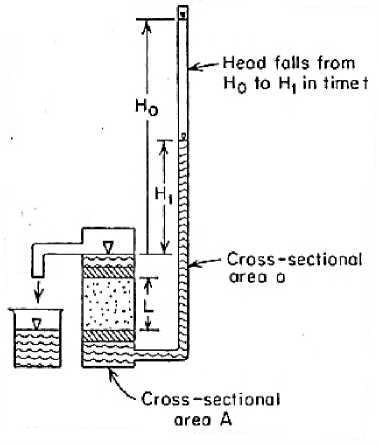
Figure 1. Permeameter
The test object that has been tested will enter the completion stage to get the hydraulic conductivity within the equation of:
k = 2,303— log ^ , A.t s h2
Which means: a = burrete total area(cm2), A = sample total area (cm2), L = Sample length (cm), t = time (detik), h 1 = first heighthead (cm), h 2 = lastheighthead (cm).
Result and Discussion
The results of physical properties testing samples of laterite, termite nests, and bentonite before mixing can be seen in Table 2. The test showed that not much different in results which each test values has quite close relation, while the bentonite sample obtain different results from LL of 351.71%, PI of 307.03% with clay grain size of 90.28%.
It can be determined from the results of physical properties test on laterite samples and termite nests classified as low plasticity clay (CL) and bentonite as high plasticity clay (CH).
Table 2.
AVERAGE VALUE OF PHYSICAL PROPERTIES PARAMETERS AND INDEX PROPERTIES
|
Parameter |
Laterite |
Termite Nests |
Bentonite |
|
Gs |
2.68 |
2.66 |
2.72 |
|
LL |
43.56% |
40.23% |
351.71% |
|
PL |
26.98% |
24.87% |
44.68% |
|
PI |
16.58% |
15.36% |
307.03% |
|
Gravel |
1.09% |
0.30% |
0.00% |
|
Coarse sand |
2.32% |
4.85% |
0.00% |
|
Medium sand |
2.14% |
3.76% |
0.00% |
|
Fine sand |
4.95% |
7.59% |
1.39% |
|
Silt |
39.09% |
30.37% |
8.33% |
|
Clay |
50.41% |
53.14% |
90.28% |
The Relationship of Termite Nests and Bentonite addition to Dry Density
The addition of 30% termite nests has considerable effect on dry density, where the value of dry density termite nests at the range 30% obtained a dry density of 1.66 g/cm3 decreased at range 15% of 1.27 g/cm3 and range 5% obtained a value of 1.42 g/cm3. Compared to bentonite with additional range of 5%, 15%, and 30%, the obtained values were close to each other, which obtain 1.32 g/cm3 at the range of 5% and increase to 1.35 g/cm3 at the range of 15% and decrease to 1,32 g/cm3 at the range of 30%.
It is known that each range addition of termite nests have sufficient effect it can be shown by the changes in density that quite far compared to the mixture of bentonite. The relationship figure of adding laterite bentonite and laterite termite nest toward the dry density can be seen in Figure 1 below.

Aditif (%)
Bentonite Sarang Rayap
Figure 2. The Relationship of Increasing Percentage of Laterite-Bentonite Mixed Content with Laterite-Termite Nests on Dry Density
The Relationship of Termite Nests and Bentonite addition to Cohesion and Inner Shear Angle
In direct shear testing for the sample testing of termite nests and bentonite, the greatest cohesion value was obtained in termite nests at the range of 15% by the total 0.1821 kg/cm2 and bentonite of 0.1206 kg/cm2 at the percentage of 30%. For cohesion, the largest angle was obtained in termite nests of 19.57 under the range of 15%, and in bentonite, it obtains 22.95° at the range of 30%.
The effect of the termite nests addition provides higher cohesion than bentonite, however, the addition of bentonite has an effect on the inner shear angle. If cohesion related to density or dry density, it is related to the termite nests that also have a considerable influence on their density.
|
Table 3. TEST RESULTS FROM THE DIRECT SHEAR TEST |
|
|
Material Bentonite |
Range C (kg/cm2) ϕ (o) 5% 0.1044 17.74 15% 0.1157 20.47 30% 0.1206 22.95 |
|
Termite nests |
5% 0.1433 18.23 15% 0.1821 19.57 30% 0.1425 18.93 |
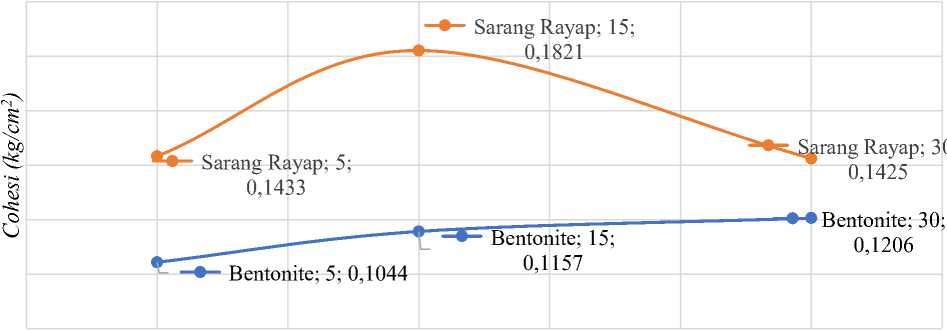
4 Bentonite; 5; 0,1044
Sarang Rayap; 5; 0,1433
■^- Bentonite; 15; 0,1157
«-• Bentonite; 30; 0,1206
Sarang Rayap; 15; 0,1821
rang Rayap; 0,1425
additives (%)
Bentonite Sarang Rayap
Figure 3. The Relationship of Increasing the range of Bentonite and Termite Nests levels on Cohesion
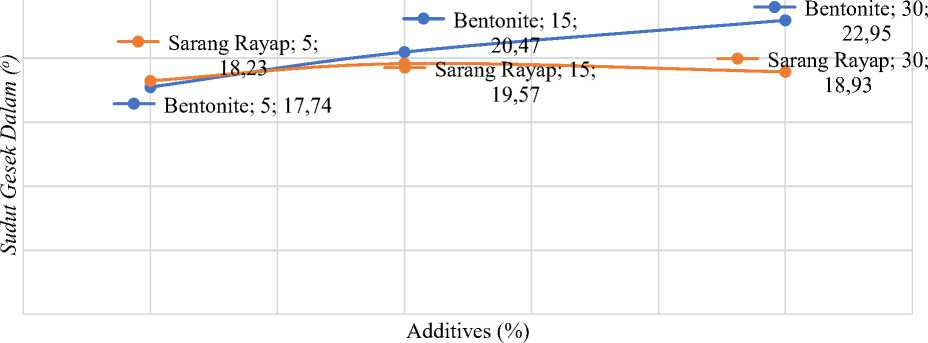
Bentonite Sarang Rayap
Figure 4. The relationship of bentonite and termite nests addition range to the inner sliding angle
The Relationship of Termite Nest and Bentonite Addition toward Hydraulic Conductivity
In the falling head test, it can be seen that bentonite has a big influence on hydraulic conductivity. It can be seen in the percentage of bentonite range of 30%, the value of hydraulic conductivity from bentonite was able to reach 6.9390E-08 cm/s. In the range of 30%, bentonite has reached the requirements as a liner within the minimum of 1.0E-07 cm/s, however, at the range of 5% and 15%, bentonite has not been able yet to reach the minimum requirements as liner.
In this study, bentonite has a role in comparison with the hydraulic conductivity of termite nests. For the termite nests testing in the falling head, the obtained value was not better than bentonite, which the smallest value obtained 1.2646E-07 cm/s within the percentage of 5%. Meanwhile, within the increase in the percentage of termite nests at 15% and 30%, the value of hydraulic conductivity increases to 3.0E-07 cm/s 3.1590E-07 cm/s at the range of 15% and 3.0668 cm/s the range of 30%
The obtained testing result can be seen as written in Figure 4 below.
The Addition of Termite Nest toward the improvement ofLaterite soils Hydraulic Conductivity
If the termite nest still not as good as bentonite at hydraulic conductivity value, will the addition of termite nests can reduce the hydraulic conductivity of the laterite soil?
Plain or pure laterite soil test using the falling head test for 3 and 7 days that was obtained with an approximate average of 1.20E-06 cm/s. It proves that the laterite soil can be stabilized for hydraulic conductivity by using termite nests.
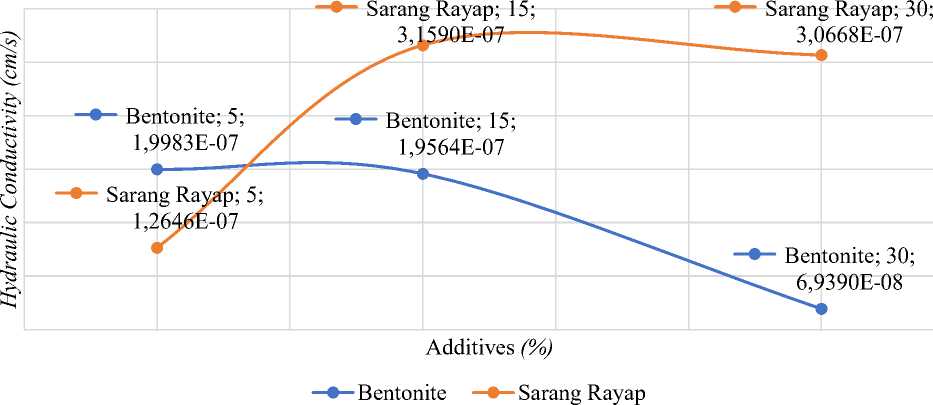
Figure 5. The Relationship of the Percentage of Addition of Bentonite and Termite Nests on Hydraulic Conductivity (k)
Conclusion
The effect of the termite nests addition on laterite soils can provide a better value of hydraulic conductivity in laterite soils, however it will not as good as the value of hydraulic conductivity of bentonite. The difference is quite far, which the addition of termite nests, the hydraulic conductivity value has not reached the minimum requirement at 1.0E-07 cm/s, whereas by adding bentonite, the content precentages is 30%, the obtained hydraulic conductivity value is 6.9390E-08 cm/s.
Список литературы The comparison study of soil permeability characteristic from clay - material mixing crays gilvus (Macrotermes gilvus Hagen) and bentonite as soil liner
- Arifin, Y. F. Pengaruh Kadar Air dan Enerji Pemadatan terhadap Hydraulic Conductivity Lempung yang Dipadatkan. Info-teknik, 2(1), 33-38.
- Lefond, S. J. (1975). Industrial Minerals and Rocks American Institute of Mining, Metallurgical, and Petroleum Engineers. Inc., New York.
- Fisher, W. L. (1965). Rock and mineral resources of East Texas.
- Meyer, V. W., Crewe, R. M., & Braack, L. E. O. (2003). Estimates of food consumption by the fungus-growing termite Macrotermes natalensis in a South African savanna-woodland: news and views. South African Journal of Science, 99(5), 207-208. https://hdl.handle.net/10520/EJC97654
- Abensperg-Traun, M., & Perry, D. H. (1998). Distribution and characteristics of mound-building termites (Isoptera) in Western Australia. Journal of the Royal Society of Western Australia, 81, 191.
- Subekti, N. (2012). Biodeteriorasi kayu pinus (Pinus merkusii) oleh rayap tanah Macrotermes gilvus Hagen (Blattodea: Termitidae). Bioteknologi Biotechnological Studies, 9(2), 57-65.
- Evans, T. A. (2003). The influence of soil heterogeneity on exploratory tunnelling by the subterranean termite Coptotermes frenchi (Isoptera: Rhinotermitidae). Bulletin of entomological research, 93(5), 413. https://doi.org/10.1079/BER2003254
- Daniel, D. E. (1987, June). Earthen liners for land disposal facilities. Geotechnical practice for waste disposal'87. ASCE, 21-39.
- Das, B. M. (1994). Mekanika Tanah (Prinsip-prinsip Rekayasa Geoteknis) jilid 2. Penerbit Erlangga.
- Noirot, C., & Darlington, J. P. (2000). Termite nests: architecture, regulation and defense. Termites: evolution, sociality, symbioses, ecology. Dordrecht, Springer, 121-139. https://doi.org/10.1007/978-94-017-3223-9_6
- Lavelle, P., & Spain, A. V. (2001). Soil ecology. Springer Science & Business Media.
- Goldman, L. J., Greenfield, L. I., Damle, A. S., Kingsbury, G. L., Northeim, C. M., & Truesdale, R. S. (1990). Clay liners for waste management facilities: design, construction and evaluation. Clay liners for waste management facilities: design, construction and evaluation.
- Adekola, K. A. (2016). Compressive strength of rice husk stabilized termite hill soil. Agricultural Engineering International: CIGR Journal, 18(1), 41-47.
- Subekti, N., & Saniaturrohmah, S. (2020). Distribution of the Termite Reproductive Castes in Gunungpati, Semarang, Central Java. Biosaintifika: Journal of Biology & Biology Education, 12(2), 282-288. https://doi.org/10.1063/L4966841

